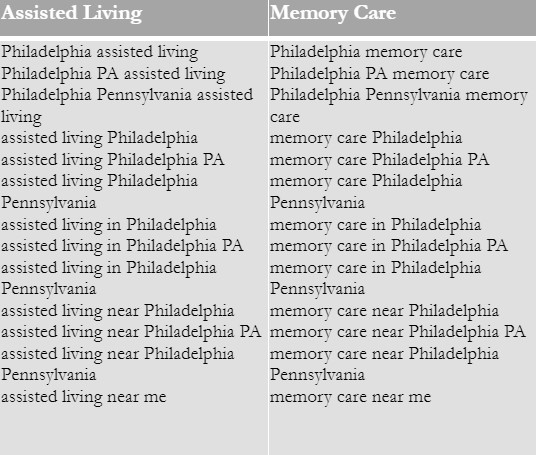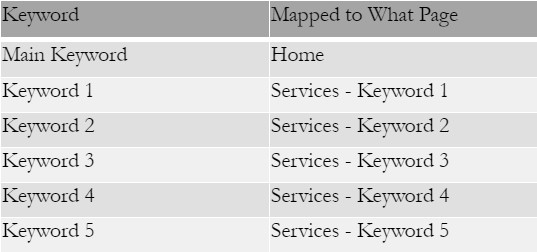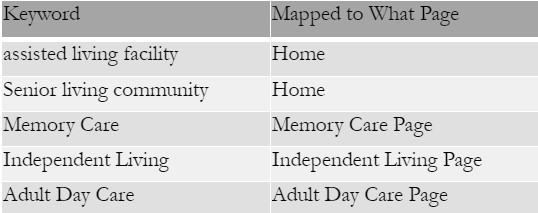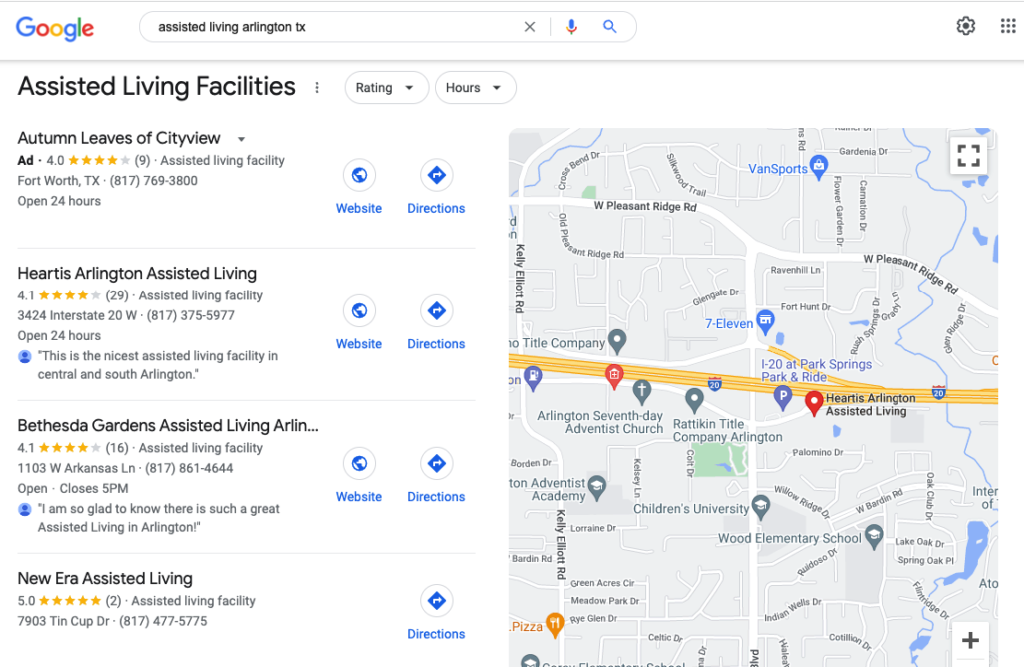Optimize your Assisted Living Facility website for the most important Keywords
In my recent book, Search engine optimization for Assisted Living Facility, I lay out several key practices for getting more tours, move-ins, and success for your facility. One of the chapters talks at length about Search Engine Optimization, or, SEO. It’s vital to the success of your community that you have a website that is optimized to be found online. Getting your company listed in the organic section (non-paid listings) of the search engines comes down to two core factors:
- Having the proper on-page optimization so Google knows what you do and the general area you serve. This allows it to put in the index for the right keywords. You do this by having pages for each of your services and then optimizing them for specific keyword combinations (Ex. Your City + main service, Your City + service 2, Your City + service 3, etc.).
- Creating enough authority and transparency so Google ranks you on page one (rather than page ten) for those specific keywords. Ultimately, it comes down to having credible inbound links and citations from other websites to your website and its sub-pages. The business with the most credible inbound links, citations, and reviews will be the most successful.
Throughout this blog, I provide specific how-to information on exactly what pages to add to your business website – and why. I also discuss what you can do to improve your authority/transparency in Google’s eyes so your website ranks on page one for the keywords which are most important to your business.
Before you start creating pages and trying to do the “on-page optimization” work, you need to be clear on the most commonly searched keywords relative to the services you offer.
By understanding the keywords, you can be sure to optimize your website for the words that will drive qualified traffic to your site. One needs to conduct detailed research of the market and the requirements that potential customers have to find the optimal keywords which will help you bring in more customers.
How to Conduct Keyword Research
To determine what your customers are searching for when they need your services, here are several tools that can be used to conduct keyword research. Some are free of charge while others have a monthly cost associated with them. Some of the better keyword research tools include Wordstream, Google AdWords Keyword Tool, Ahrefs, and SEM Rush.
For this book, we have developed instructions based on the free Google AdWords Keyword tool. To use the Google AdWords Keyword tool, you’ll need to:
- Develop a list of your services and save it in a .txt file
- Develop a list of the cities that you operate in (your primary city of service and the smaller surrounding towns) and save it in a .txt file
- Go here and Use Toptal’s tool for Merge Words.
Now that you’re at merge words, you’ll want to follow this click path. 1) Paste your list of cities in column one 2) Paste your list of services in column two 3) Press the “Merge!” button.
The tool will generate a list of all your services combined with your cities of service.
- Go to Google.com and search “Google Keyword Tool” or go directly to https://adwords.google.com/o/KeywordTool
Now that you’re inside the AdWords tool, paste your list of merged keywords into the “word or phrase” box and press submit. - You will now see a list of each of your keywords with a “search volume” number beside it
- Sort the list from greatest to smallest
You now have a list of the most commonly searched keywords in your area.
With this list, you can map out keywords to specific pages on your website, and rest assured that you are basing your strategy on opportunity rather than a guesstimate.
Most Commonly Searched Assisted Living Industry Keywords
Below you will find the list of the most commonly searched keywords for the Assisted Living space.
| assisted living near me | 135,000 |
| senior living near me | 60,500 |
| assisted living facilities near me | 27,100 |
| senior communities near me | 6,600 |
| senior homes near me | 4,400 |
| senior home near me | 4,400 |
| senior living community near me | 3,600 |
| senior care near me | 3,600 |
| senior assisted living near me | 2,900 |
| assisted living homes near me | 1,900 |
| assisted living home near me | 1,900 |
| memory care near me | 790 |
Based on this data, to get the most from the Internet from an SEO perspective, you will want to create content on your website for the following keyword combinations that would make sense for your area. The example below is for Philadelphia, PA. This table is showing keywords for the category of Assisted Living and Memory Care. You could do the same thing for other categories like: Senior Living, Independent Living Home, Assisted Living Facilities, and so on.

How to Map Out Your Website Pages for Maximum Result
Now that you are set to determine the most commonly searched keywords in your field, you can begin mapping out the pages which need to be added to your website.
Keep in mind each page on your website can only be optimized for 1-2 keyword combinations. If you came up with 25 keywords, then you are going to need at least 12 – 15 landing pages.
Be sure you have each keyword mapped to a specific page on your site.

Here is an example of an Assisted Living Facility that has the following keywords: assisted living facility, senior living community, memory care, independent living, and adult day care.

Now that you have mapped out the pages to be included on your website, you can start thinking about how to optimize each of those pages for the major search engines (Google, Bing, Duck Duck Go, Neeva).
How to Optimize for Ranking in the Organic Listings
Step 1 – Build the website and obtain keyword placeholders
A typical services website has only 5-6 pages (Home – About Us – Our Services – Testimonials – Contact Us). That does not create a lot of indexation or placeholders on the major search engines. Most ALFs, for example, provide a wide variety of services, as covered in the Keyword Research section of this chapter.
By building out the website and creating separate pages highlighting each of these services offered (combined with city modifiers), a business can get listed on the search engines for each of those different keyword combinations. Here is an example:
Home – About – Coupons – Contact Us
Sub-pages for each service – Dallas Assisted Living, Dallas Memory Care, Dallas Adult Day Care, Dallas Independent Living, Dallas Senior Living Community. Assisted Living Facilities often provide services in a large number of locations outside of their primary city. To be found on the major search engines for EACH of those sub-cities, additional pages need to be created:
- Sub-pages for each sub-city serviced – Assisted Living, Memory Care, Independent Living, etc.
Step 2 – Optimize Pages for Search Engines:
Once the pages and sub-pages are built for each of your core services, each page needs to be optimized from an SEO perspective to make the search engines understand what the page is about.
Here are some of the most important items that need to be taken care of for on-page search engine optimization:
- Unique Title Tag on each page
- H1 Tag restating that Title Tag on each page
- Images named with primary keywords (alt text)
- URL containing page keyword
- Anchor Text on each page and built into Footer – Dallas Assisted Living Facility
- XML Sitemap should be created and submitted to Google Webmaster Tools and Bing Webmaster Tools
How to Build Up Website Authority
Once the pages are built and the “on-page” SEO is complete, the next step is getting inbound links so you can rank on page one for your most important keywords.
Everything we have discussed to this point is sort of like laying the groundwork. The pages need to be in the running. However, it is the number of QUALITY inbound links and web references to those pages that are going to determine placement.
30% of SEO is On-Page type work. The other 70% is Link Building
Building the pages is just the beginning. The only way to get your site to rank above your competition is by having MORE quality inbound links and citations to your site.
Again, if there is any secret sauce to ranking well in the search engines, it is links and authority. The major caveat? You can’t just use garbage links. You don’t want to just have a thousand links. When I say links, I’m referring to other websites hyper-linking to your website, which I’ll explain a little bit more with specific examples.
Some of the latest algorithm changes (Google Panda and Google Penguin) involve Google trying to prevent spam. A lot of Internet marketers and SEO coordinators realize it’s all about the links. That is what the Google algorithm was built upon. They figured out ways to get a variety of links with random anchor text pointed back to the pages that they want to have ranked. Google has recognized that if those links are not relevant, then they don’t add any value to the Internet.
Bad or irrelevant links can hurt your ranking more than help it. It’s about getting quality, relevant links back to your home page and subpages through content creation and strategic link-building. How do you get the links? Where do you get the links?
Take a look at the list of links below as a point of reference.
- Association Links – Be sure that you have a link to your site from any industry associations that you belong to (Ex. Business associations, Chamber of Commerce, Networking Groups, etc.).
- Directory Listings – Get your site listed on as many directory-type websites as possible (Angie’s List, Yahoo Local Directory, Judy’s Book, Yelp.com, etc.)
- Create Interesting Content/Articles – This is probably the #1 source of inbound links. For example, you can write an article about a particular service offering in your industry and push it out to thousands of people through article directory sites that may each contain a link back to a specific page on your site.
- Competitive Link Acquisition – This is the process of using tools like Raven Tools, SEO Book, and others to see what links your top competitors have, and then get those same or similar links pointed back to your website.
- Local Links – ALFs are local and that means you need links from local organizations. Here you need to be thinking about private schools, churches, and sports associations. This can be an easy opportunity to capitalize on the things you’re already doing in the community. See if the sponsorships are available or if they would be interested in something like this if they don’t already have a program.
Directory Links
There are several of what I like to call “low-hanging fruit” links. It all starts with your online directory listings.
Some examples include Google Business Profile, City Search, Yelp.com, Judy’s Book, Best of the Web, Yellow Pages, Hot Frog, Assisted Living Directory, and the list goes on. All of those online listings let you display your company name, address, phone number, and a link back to your website. Some of them even allow reviews.
For the most part, adding your business information to those directories is completely free of charge. You want to make sure that you have your company listed on as many of the online directory listings as possible for authoritative linking reasons. They’re also valuable from the Google Maps optimization perspective because they give you citations which are very important for getting ranked on the map.
A great way to find additional online directories to add your company to would be to run a search on Google for “Assisted Living Facility – Business Directory” or “Your City – Business Directory”. This will give you a great list of potential directory sites to add your company to. There are also tools for this like BrightLocal or White Spark that can provide you with a list of directory sources based on your industry. After beginning with online directory listings, you want to look at any associations you’re involved with.
Association Links
I’m assuming you are involved in some type of association, whether it is the national industry association, the local chapter, or some other group affiliation. Visit the websites of those organizations and get listed in the member section. This will give you citations and the opportunity to link back to your website.
Local Association
Other local associations that you’re involved in. If you’re a member of the Chamber of Commerce, a networking group like BNI (Business Networking International), or if you’re involved with a local charity, find out if they list their members on their websites. Another great place to get links is by typing in your city directory.
Non-Competitive Affiliated Industries and Local Businesses
You can work with colleagues that have affiliated industry-type businesses.
Supplier Sites
Look at the suppliers you purchase from and try to coordinate a deal with them. Oftentimes, the places where you buy your merchandise will have a section on their website that mentions their value-added resellers. You can get a link from those.
Social Media Profile Links
The other “low-hanging fruit” links are social media profiles. We have a whole chapter about the power of social media and how you can harness it to get repeat and referral business.
Simply from a link-building perspective, you should set up a Facebook page, Twitter account, LinkedIn profile, Pinterest profile, and YouTube channel and place a link to your website on each. All of them will allow you to enter your company’s name, address, phone number, description, and, of course, a place to put your website address.
Competitive Link Acquisition
You might be surprised that if you tackle these elements and you don’t do any of the other things we have discussed, you will notice that you’ve probably got enough links to outrank your competition in your area.
I want to share some additional thoughts and strategies on how you can accomplish even more from a link-building perspective. A very powerful strategy that you can implement is called Competitive Link Acquisition.
The way I like to think of it is that if quantity inbound links are the secret sauce to outranking your competition, and if we could figure out who’s linking to your competition or what links your competition has, we can get those same or similar links pointed back to your website, then you can outrank them because you’ll at that point have more authority.
Competitive link acquisition is the process of figuring out who is in the top position for your most important keywords, reverse engineering their link profile to see what links they have, and getting those same or similar links pointed back to your website. A simple way to do this is just to go to Google.com and type in “your city + your service,” and find out who is in the top few positions.
Let’s take a look at the number one placeholder. They are there because their website is optimized well and Google knows it should be ranked well based on the quality and quantity of inbound links compared to the competition.
Once you identify the competitor, you can use a couple of different tools such as Raven Tools, Majestic SEO, Back Link Watch, etc., and you can take their URL, input it into your tool of choice, run the report, and get a list of links in return.

So, your number one competitor is competitor.com. Your tool spits out a list showing they have 392 inbound links.
- There’s a link from the local Chamber of Commerce
- There’s a link from the PHCC
- There’s a link from an article that was posted in the local newspaper
- There’s a link from the local networking chapter
By analyzing the types of links the competitor has, you can systematically mimic those links and get them pointed back to your website.
Don’t just do this for your first competitor, but also for your second and third and fourth, and fifth competitors. By doing this on a consistent basis, you can start to dominate the search engines for your most important keywords.
If you build out your site for your services and sub-services, optimize the pages using SEO best practices and then systematically obtain inbound links, you will start to DOMINATE the search engines for your service-related keywords in your area.
Content Marketing Strategies for Maintaining Relevance
Another highly important factor in SEO is maintaining relevance in your market by adding ongoing relevant updates to your website. It is still true that content is king.
Google Loves Fresh Content
In some cases, with the changes in the algorithm, just because you’ve got a great website with the right title tags and all the best links, you may get discounted if they’re not seeing fresh information posted consistently.
Google loves fresh content, and it is important to have a methodology where you are creating and posting content to your website regularly. I want to give you a framework for figuring out what kind of content you could write, why you should create content, and how you can do it consistently.
First, you need to understand and accept that you need to become a subject matter expert. You might not consider yourself a writer or a content creator, but you are a subject matter expert. There are things you know that the general population does not. You’re an expert when it comes to the service you are offering, and you have a team of people who are proficient in this area as well. You can create content on the topic that you know most about.
You can write about a variety of different topics including 1-2 relevant keywords with the same. You may not think it at first, but there are a lot of different topics in your industry you can come up with to create content about.
Types of Content
You should also consider that content doesn’t have to be just written words. It doesn’t have to be just articles. Content can come in a variety of forms. The most popular are going to be articles, photos, videos, and audio files. Stop and think about what content creation method works best for you.
Some people are great writers and that’s their strength. Other people like to be on camera. I like to create videos. I’m very comfortable creating videos. Other people can talk (and they can talk your ear off about whatever topic they are passionate about!)
You can create content in many different ways. Because it is what I enjoy, I’ll use video as an example. A business director can set up a camera and record themselves explaining the services their company has to offer in the market, in the same manner, that they would explain it to a customer.
Now you’ll have multiple pieces of content. You’ll have a video, which can be uploaded to YouTube, Vimeo, Meta Café, etc. This one piece of content can create multiple invaluable links to your website. You can also take that video, save the audio portion of it, and you’ve got an audio clip. You can upload that audio file to your website and post it on other various sites.
You can use a transcription service like Rev or Descript, for instance, where you upload the audio or video file and somebody converts it to text or they’ll use AI for an even cheaper price. For a couple of bucks, you’ll have a complete article comprised of what you said. Now you’ve got a piece of content you can post to your blog. You can put it on eHow or one of those other article directory sites.
Content Consistency
You want to create content consistently, using the blog on your website as the hub to post it, but then syndicating it to various sources.
Syndicating it to article directory sites if it’s in text form, and sending it to video sites like Vimeo, Metacafe, and YouTube.com if it’s in video form. Doing this keeps the content fresh on your website/domain and creates a lot of authority, which is going to help with the overall ranking of the website on search engines.
You want to make sure you’re appropriating each one of these link-building opportunities to maximize your rank potential in your area. You might be surprised that the services you offer are highly competitive from an SEO perspective. There are a lot of companies who want to rank for the same keywords, and many of them have invested heavily in the Internet and in getting themselves higher in search engines.
Now that you’ve built out your website, you’ve optimized it correctly, and you’ve got an ongoing link-building and content development strategy in place, you want to start looking at Google Business Profile Optimization. and getting ranked on the Google Map Pack.
Conclusion
SEO for an Assisted Living Facility can be challenging because of the competition. But by following the steps in this guide, and by being consistent with your SEO strategy, you will see results. It’s important to note that SEO is an ongoing process. You can’t just set it and forget it. You need to continuously work on it, especially if you want to maintain or improve your ranking. If you recognize that these principles are important for your website and need to implement them, but are unsure about having the time or expertise available to take them on, don’t hesitate to reach out. At Aveta Marketing, we specialize in SEO for Assisted Living Facilities just like yours and can help point you in the right direction.







